2014 MERCEDES-BENZ B-CLASS SPORTS sensor
[x] Cancel search: sensorPage 8 of 360
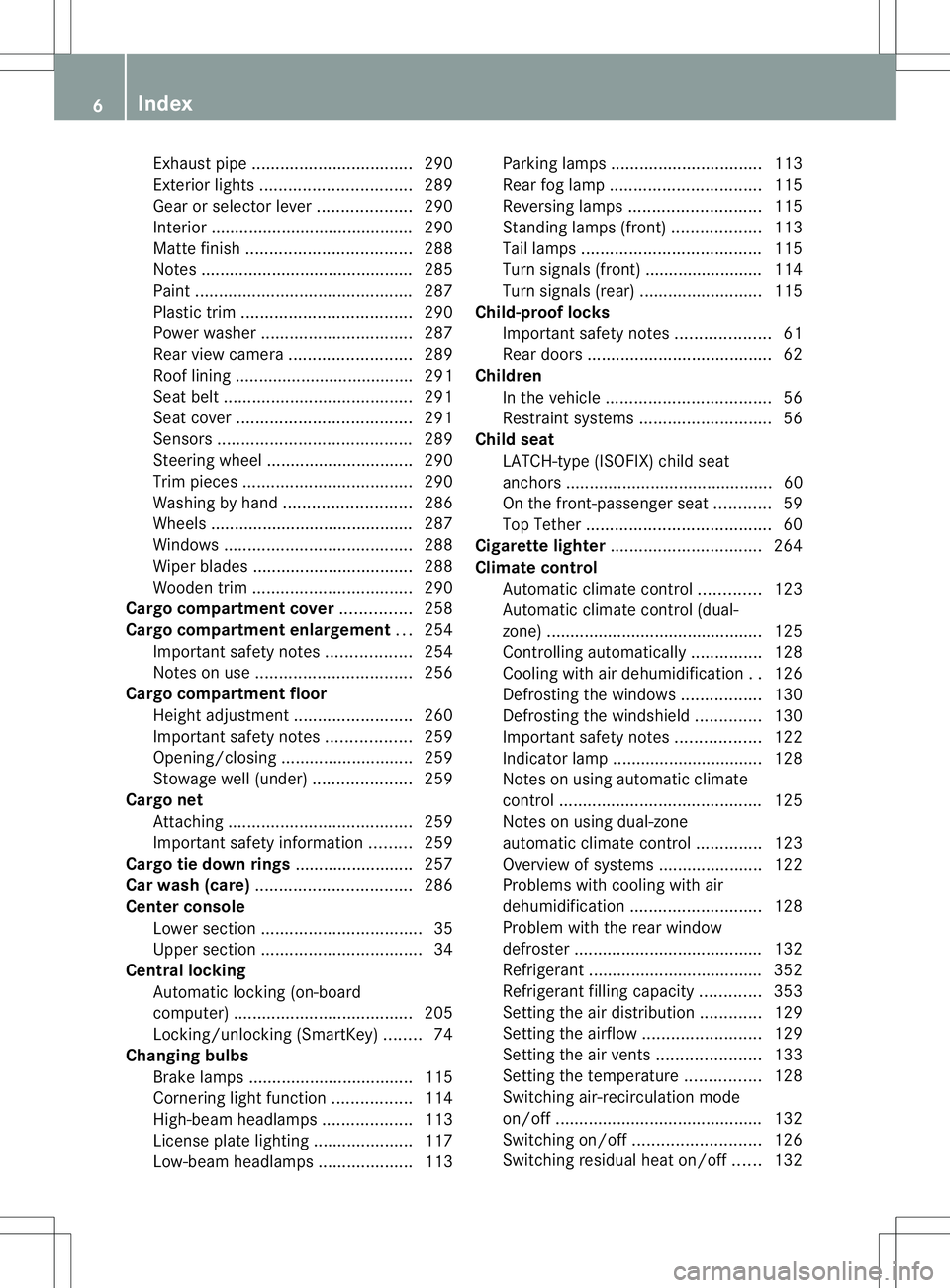
Exhaus
tpipe .................................. 290
Exterior lights ................................ 289
Gea rors electo rlever .................... 290
Interior ........................................... 290
Matte finish ................................... 288
Notes ............................................. 285
Paint .............................................. 287
Plastic trim .................................... 290
Power washer ................................ 287
Rea rview camera .......................... 289
Roo flining ...................................... 291
Seat bel t........................................ 291
Seat cover ..................................... 291
Sensors ......................................... 289
Steering wheel ............................... 290
Trim pieces .................................... 290
Washing by hand ........................... 286
Wheels ........................................... 287
Windows ........................................ 288
Wiper blades .................................. 288
Wooden trim .................................. 290
Cargo compartment cover ...............258
Cargo compartment enlargement ...254
Important safety notes ..................254
Notes on use ................................. 256
Cargo compartment floor
Height adjustment .........................260
Important safety notes ..................259
Opening/closing ............................ 259
Stowag ewell (under) ..................... 259
Cargo net
Attaching ....................................... 259
Important safety information .........259
Cargo tie dow nrings ......................... 257
Car wash (care) ................................. 286
Center console Lowe rsection .................................. 35
Uppe rsection .................................. 34
Central locking
Automatic locking (on-board
computer) ...................................... 205
Locking/unlocking (SmartKey) ........74
Changing bulbs
Brake lamps ................................... 115
Cornering light function .................114
High-beam headlamps ...................113
License plate lighting .....................117
Low-beam headlamps ....................113Parking lamps
................................ 113
Rea rfog lamp ................................ 115
Reversing lamps ............................ 115
Standing lamps (front) ...................113
Tai llamps ...................................... 115
Turn signals (front) ......................... 114
Turn signals (rear) ..........................115
Child-proof locks
Important safety notes ....................61
Rea rdoors ....................................... 62
Children
In the vehicle ................................... 56
Restraint systems ............................ 56
Child seat
LATCH-typ e(ISOFIX) chil dseat
anchors ............................................ 60
On the front-passenger sea t............ 59
Top Tether ....................................... 60
Cigarette lighter ................................ 264
Climate control Automatic climate control .............123
Automatic climate control (dual-
zone) .............................................. 125
Controlling automatically ...............128
Cooling with aird ehumidification..126
Defrosting the windows .................130
Defrosting the windshield ..............130
Important safety notes ..................122
Indicator lamp ................................ 128
Notes on using automatic climate
control ........................................... 125
Notes on using dual-zone
automatic climate control ..............123
Overview of systems ......................122
Problems with cooling with air
dehumidification ............................ 128
Problem with the rear window
defroster ........................................ 132
Refrigerant ..................................... 352
Refrigerant filling capacity .............353
Setting the aird istribution.............129
Setting the airflow .........................129
Setting the airv ents...................... 133
Setting the temperature ................128
Switching air-recirculation mode
on/off ............................................ 132
Switching on/off ........................... 126
Switching residua lheato n/off ......132 6
Index
Page 14 of 360
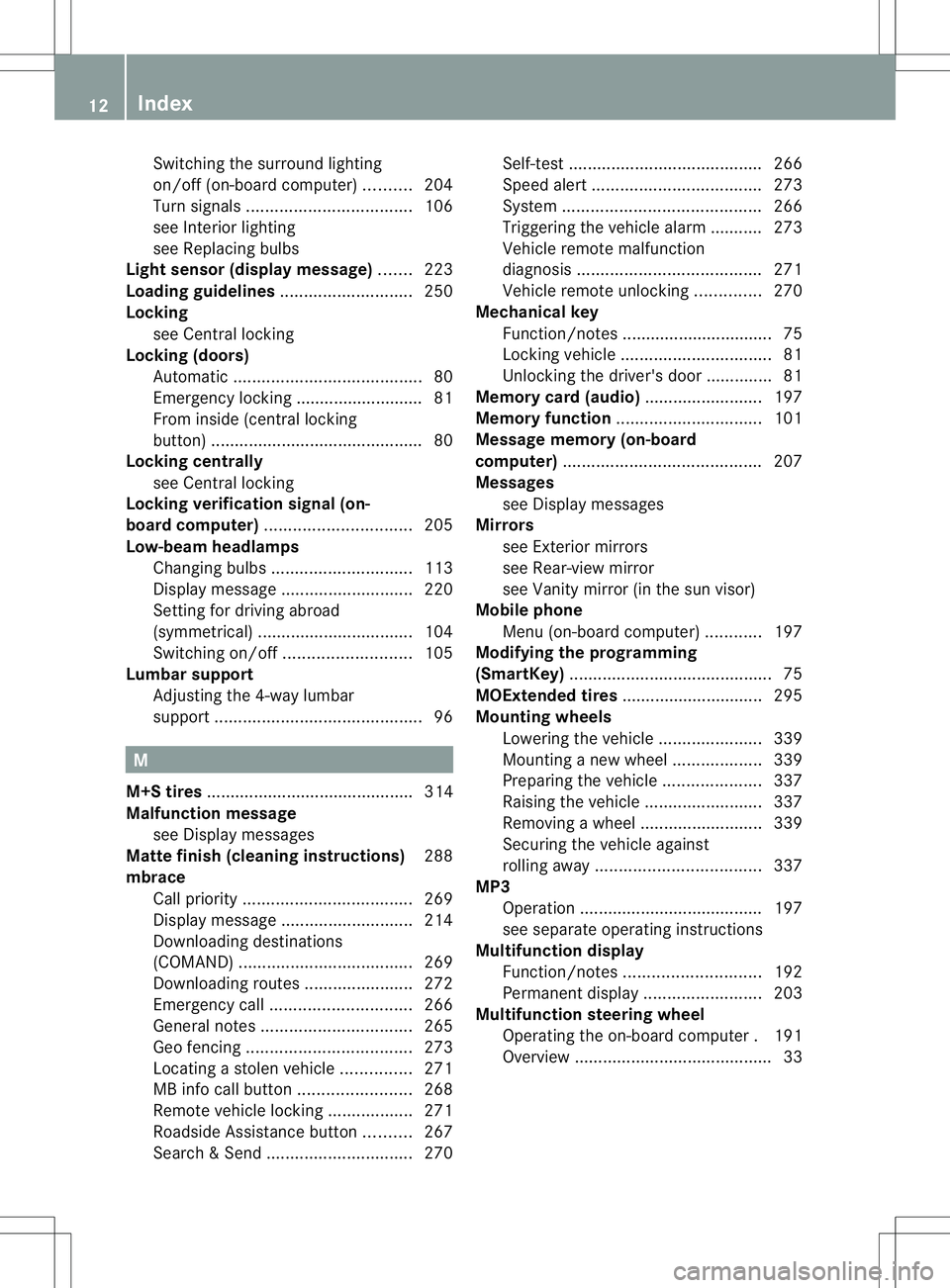
Switching the surround lighting
on/of
f(on -board computer) ..........204
Turn signals ................................... 106
see Interior lighting
see Replacing bulbs
Light sensor (display message) .......223
Loading guidelines ............................250
Locking see Centra llocking
Locking (doors)
Automatic ........................................ 80
Emergency locking ........................... 81
From insid e(central locking
button) ............................................. 80
Locking centrally
see Centra llocking
Locking verification signal (on-
board computer) ............................... 205
Low-beam headlamps Changing bulbs .............................. 113
Display message ............................ 220
Setting for driving abroad
(symmetrical) ................................. 104
Switching on/off ........................... 105
Lumbar support
Adjusting the 4-way lumbar
support ............................................ 96M
M+S tires ............................................ 314
Malfunction message see Display messages
Matte finish (cleaning instructions) 288
mbrace Call priority .................................... 269
Display message ............................ 214
Downloading destinations
(COMAND) ..................................... 269
Downloading route s....................... 272
Emergency call .............................. 266
General notes ................................ 265
Geo fencing ................................... 273
Locating astolen vehicl e............... 271
MB info call button ........................268
Remote vehicle locking ..................271
Roadside Assistance button ..........267
Search &Send ............................... 270Self-test
......................................... 266
Speed alert .................................... 273
System .......................................... 266
Triggering the vehicle alarm ........... 273
Vehicle remote malfunction
diagnosi s....................................... 271
Vehicle remote unlocking ..............270
Mechanical key
Function/notes ................................ 75
Locking vehicle ................................ 81
Unlocking the driver's door ..............81
Memory card (audio) .........................197
Memory function ............................... 101
Message memory (on-board
computer) .......................................... 207
Messages see Display messages
Mirrors
see Exterior mirrors
see Rear-view mirror
see Vanity mirror (in the sun visor)
Mobile phone
Menu (on-board computer) ............197
Modifying the programming
(SmartKey) ........................................... 75
MOExtende dtires .............................. 295
Mounting wheels Lowerin gthe vehicle ...................... 339
Mounting anew wheel ................... 339
Preparing the vehicle .....................337
Raising the vehicle .........................337
Removing awheel .......................... 339
Securing the vehicle against
rolling away ................................... 337
MP3
Operation ....................................... 197
see separate operating instructions
Multifunctio ndisplay
Function/notes ............................. 192
Permanent displa y......................... 203
Multifunctio nsteering wheel
Operating the on-board computer .191
Overview .......................................... 3312
Index
Page 16 of 360
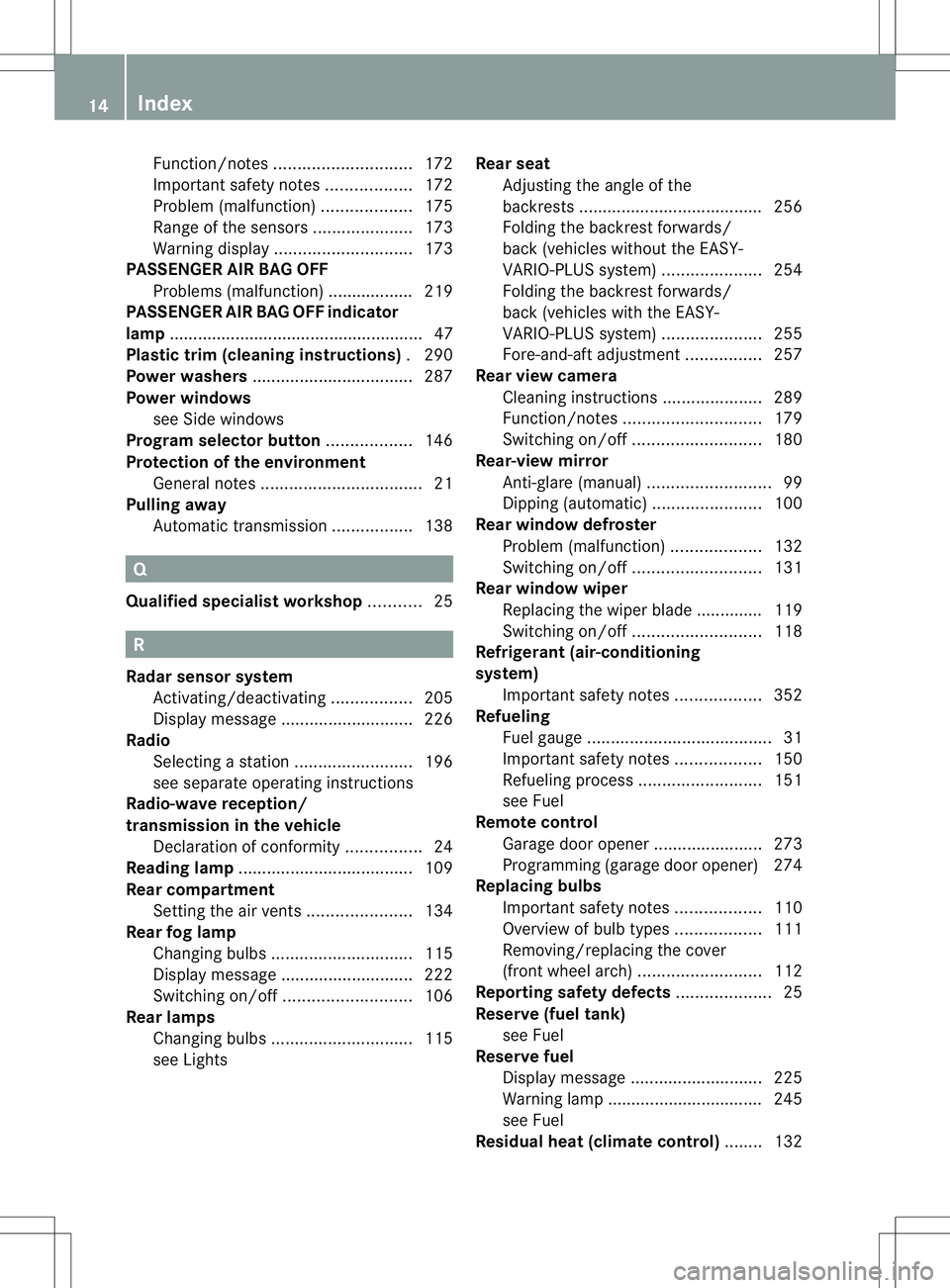
Function/notes
............................. 172
Important safety notes ..................172
Problem (malfunction) ...................175
Range of the sensors .....................173
Warning displa y............................. 173
PASSENGE RAIR BAG OFF
Problem s(malfunction) .................. 219
PASSENGER AIR BAG OFF indicator
lamp ...................................................... 47
Plastic trim (cleaning instructions) .290
Power washers .................................. 287
Power windows see Side windows
Program selector button ..................146
Protection of the environment General notes .................................. 21
Pulling away
Automatic transmission .................138 Q
Qualifie dspecialis tworkshop ...........25 R
Radar sensor system Activating/deactivating .................205
Display message ............................ 226
Radio
Selecting astation ......................... 196
see separate operating instructions
Radio-wave reception/
transmission in the vehicle
Declaratio nofconformity ................ 24
Readin glamp ..................................... 109
Rear compartment Setting the airv ents...................... 134
Rear fog lamp
Changing bulbs .............................. 115
Display message ............................ 222
Switching on/off ........................... 106
Rear lamps
Changing bulbs .............................. 115
see Lights Rear seat
Adjusting the angl eofthe
backrests ....................................... 256
Folding the backres tforwards/
back (vehicles without the EASY-
VARIO-PLUS system) .....................254
Folding the backrest forwards/
back (vehicle switht he EASY-
VARIO-PLUS system) .....................255
Fore-and-aft adjustment ................257
Rear vie wcamera
Cleaning instructions .....................289
Function/notes ............................. 179
Switching on/off ........................... 180
Rear-vie wmirror
Anti-glare (manual ).......................... 99
Dipping (automatic) .......................100
Rear window defroster
Problem (malfunction) ...................132
Switching on/off ........................... 131
Rear window wiper
Replacing the wiper blade .............. 119
Switching on/off ........................... 118
Refrigerant (air-conditioning
system)
Important safety notes ..................352
Refueling
Fuel gauge ....................................... 31
Important safety notes ..................150
Refueling proces s.......................... 151
see Fuel
Remote control
Garage door opener .......................273
Programming (garage door opener) 274
Replacing bulbs
Important safety notes ..................110
Overview of bul btypes .................. 111
Removing/replacing the cover
(front wheel arch) .......................... 112
Reportin gsafety defects ....................25
Reserve (fue ltank)
see Fuel
Reserve fuel
Display message ............................ 225
Warning lamp ................................. 245
see Fuel
Residual heat (climate control) ........132 14
Index
Page 17 of 360
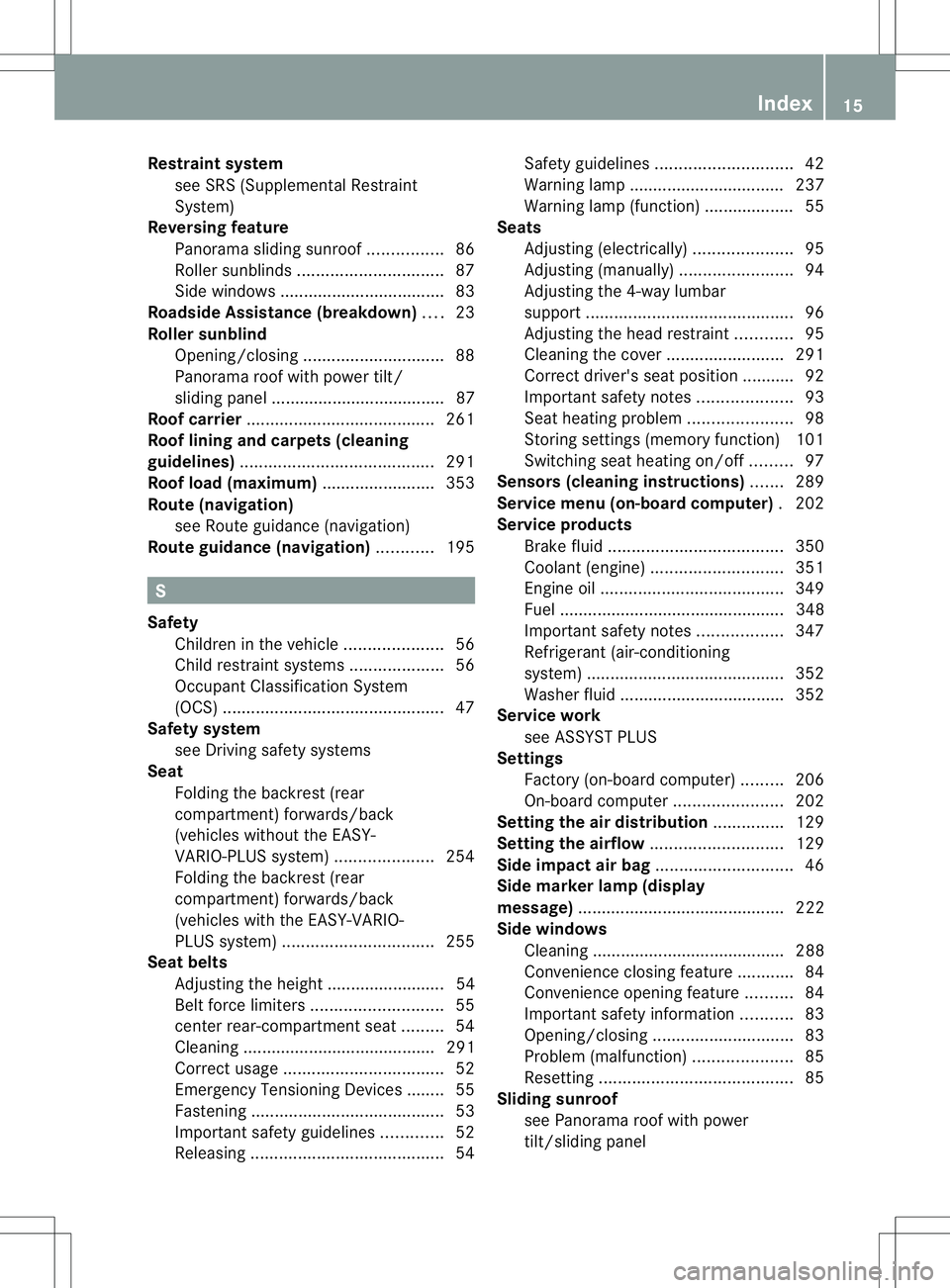
Restraint system
see SRS (Supplemental Restraint
System)
Reversin gfeature
Panorama sliding sunroof ................86
Roller sunblinds ............................... 87
Side windows ................................... 83
Roadside Assistanc e(breakdown) ....23
Roller sunblind Opening/closing .............................. 88
Panorama roof with power tilt/
sliding pane l..................................... 87
Roof carrier ........................................ 261
Roof lining and carpets (cleaning
guidelines) ......................................... 291
Roof load (maximum) ........................353
Route (navigation) see Route guidance (navigation)
Route guidance (navigation) ............195 S
Safety Childre ninthe vehicle ..................... 56
Child restraint systems ....................56
Occupant Classification System
(OCS) ............................................... 47
Safety system
see Driving safety systems
Seat
Folding the backres t(rear
compartment) forwards/back
(vehicles withou tthe EASY-
VARIO-PLUS system) .....................254
Folding the backres t(rear
compartment) forwards/back
(vehicles with the EASY-VARIO-
PLUS system) ................................ 255
Seat belts
Adjusting the height ......................... 54
Belt force limiters ............................ 55
center rear-compartment sea t......... 54
Cleaning ......................................... 291
Correct usage .................................. 52
Emergency Tensioning Devices ....... .55
Fastening ......................................... 53
Important safety guidelines .............52
Releasing ......................................... 54Safety guidelines
............................. 42
Warning lamp ................................. 237
Warning lamp (function) ................... 55
Seats
Adjusting (electrically). ....................95
Adjusting (manually). .......................94
Adjusting the 4-way lumbar
support ............................................ 96
Adjusting the hea drestraint ............ 95
Cleaning the cover .........................291
Correct driver's sea tposition ........... 92
Important safety notes ....................93
Seat heating problem ......................98
Storing settings (memory function) 101
Switching sea theating on/off .........97
Sensors (cleaning instructions) .......289
Service menu (on-board computer) .202
Service products Brake fluid ..................................... 350
Coolant (engine) ............................ 351
Engine oil ....................................... 349
Fuel ................................................ 348
Important safety notes ..................347
Refrigerant (air-conditioning
system) .......................................... 352
Washer fluid .................................. .352
Service work
see ASSYST PLUS
Settings
Factory (on-board computer) .........206
On-board computer .......................202
Settin gthe air distribution ...............129
Settin gthe airflow ............................ 129
Side impact air bag .............................46
Side marker lamp (display
message) ............................................ 222
Side windows Cleaning ......................................... 288
Convenience closing feature ............84
Convenience opening feature ..........84
Important safety information ...........83
Opening/closing .............................. 83
Problem (malfunction) .....................85
Resetting ......................................... 85
Sliding sunroof
see Panorama roof with power
tilt/sliding panel Index
15
Page 23 of 360
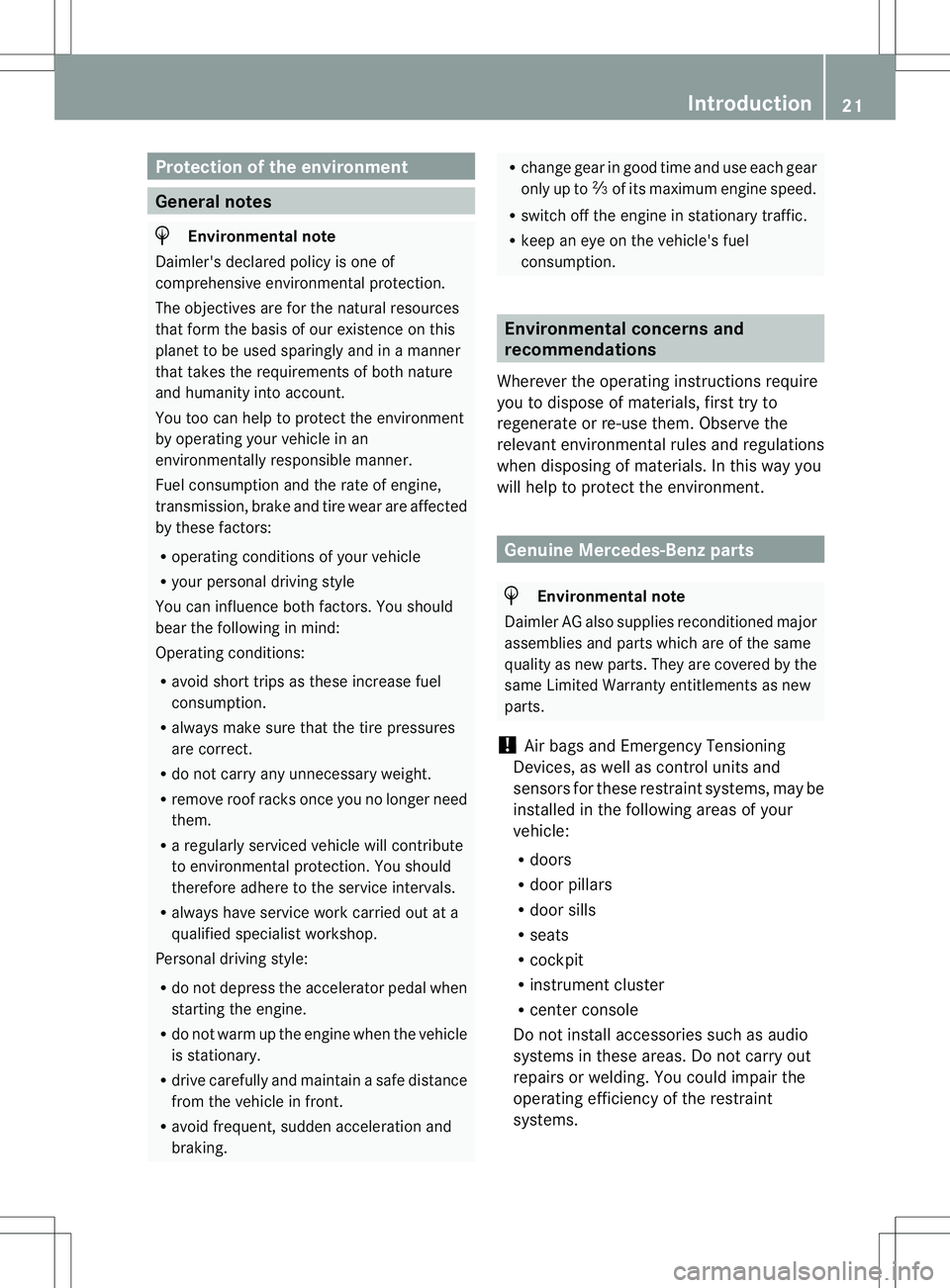
Protection of the environment
General notes
H
Environmental note
Daimler's declared policy is one of
comprehensive environmental protection.
The objectives are for the natural resources
that form the basis of our existence on this
planet to be used sparingly and in amanner
that takes the requirements of both nature
and humanity into account.
You too can help to protect the environment
by operating your vehicle in an
environmentally responsible manner.
Fuel consumption and the rate of engine,
transmission, brake and tire wear are affected
by these factors:
R operating condition sofyour vehicle
R your personal driving style
You can influence both factors. You should
bear the following in mind:
Operating conditions:
R avoid short trips as these increase fuel
consumption.
R always make sure that the tire pressures
are correct.
R do not carry any unnecessary weight.
R remove roof racks once you no longer need
them.
R ar egularly serviced vehicle will contribute
to environmental protection. You should
therefore adhere to the service intervals.
R always have service work carried out at a
qualified specialist workshop.
Personal driving style:
R do not depress the accelerator pedal when
startingt he engine.
R do not warm up the engine when the vehicle
is stationary.
R drive carefully and maintain asafe distance
from the vehicle in front.
R avoid frequent, sudden acceleration and
braking. R
change gear in good time and use each gear
only up to 001Bof its maximum engine speed.
R switch off the engine in stationary traffic.
R keep an eye on the vehicle's fuel
consumption. Environmental concerns and
recommendations
Wherever the operating instructions require
you to dispose of materials, first try to
regenerate or re-use them. Observe the
relevant environmental rules and regulations
when disposing of materials. In this way you
will help to protect the environment. Genuine Mercedes-Benz parts
H
Environmental note
Daimler AG also suppliesr econditioned major
assemblies and parts which are of the same
quality as new parts. They are covered by the
same Limited Warranty entitlements as new
parts.
! Air bags and Emergency Tensioning
Devices, as well as control units and
sensors for these restraint systems, may be
installed in the following areas of your
vehicle:
R doors
R door pillars
R door sills
R seats
R cockpit
R instrumen tcluster
R center console
Do not install accessories such as audio
systems in these areas. Do not carry out
repairs or welding. You could impair the
operating efficienc yofthe restraint
systems. Introduction
21 Z
Page 43 of 360
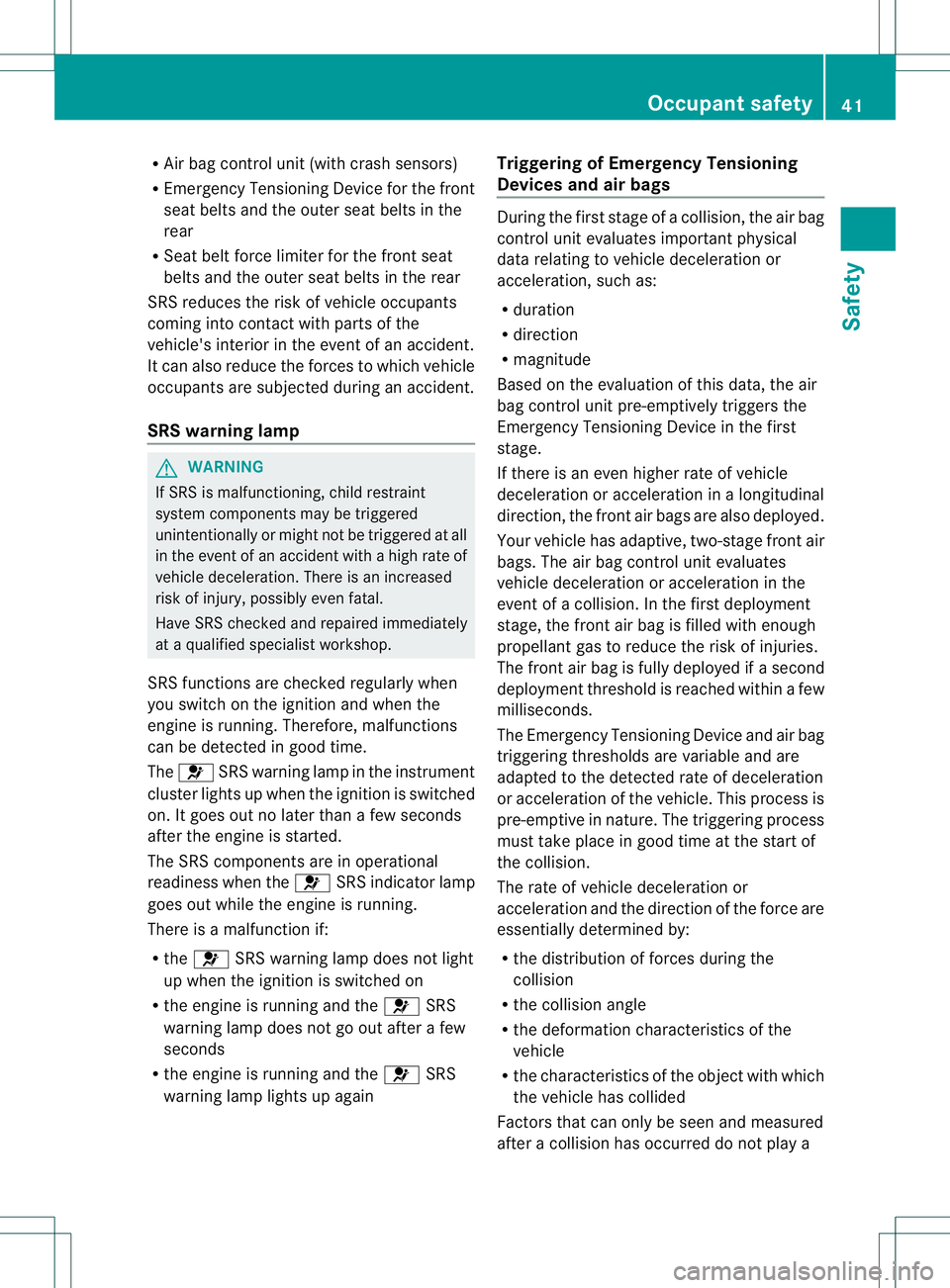
R
Air ba gcontro lunit( with crash sensors)
R Emergenc yTensioning Device for th efront
seat belt sand th eoute rseat belts in the
rear
R Seat belt forc elimiter for the fron tseat
belts and the outer seat belts in the rear
SRS reduces the risk of vehicle occupants
comin gintoc ontact with parts of the
vehicle's interior in the event of an accident.
It can also reduce the forces to which vehicle
occupants are subjected during an accident.
SRS warning lamp G
WARNING
If SRS is malfunctioning, child restraint
system component smay be triggered
unintentionally or might not be triggered at all
in the event of an acciden twith ahigh rate of
vehicle deceleration. There is an increased
risk of injury, possibly even fatal.
Have SRS checked and repaire dimmediately
at aq ualified specialist workshop.
SRS function sare checked regularly when
you switc honthe ignition and when the
engin eisrunning. Therefore, malfunctions
can be detected in good time.
The 0021 SRS warnin glamp in the instrument
cluster light supwhen the ignition is switched
on. It goes out no later than afew seconds
after the engin eisstarted.
The SRS component sare in operational
readiness when the 0021SRS indicator lamp
goes out while the engin eisrunning.
There is amalfunction if:
R the 0021 SRS warnin glamp does not light
up when the ignition is switched on
R the engin eisrunning and the 0021SRS
warnin glamp does not go out after afew
seconds
R the engin eisrunning and the 0021SRS
warnin glamp light supagain Triggering of Emergency Tensioning
Devices and air bags Durin
gthe firs tstag eofac ollision, the ai rbag
control unit evaluates important physical
dat arelating to vehicle deceleratio nor
acceleration, suc has:
R duration
R direction
R magnitude
Based on th eevaluation of this data, th eair
bag control unit pre-emptivel ytrigger sthe
Emergency Tensioning Devic einthefirst
stage.
If there is an eve nhigher rat eofvehicle
deceleratio noracceleration in alon gitudinal
direction, the front ai rbags are also deployed.
Your vehicle has adaptive, two-stag efront air
bags. The air bag control unit evaluates
vehicle deceleration or acceleration in the
even tofa collision. In the firs tdeployment
stage, the fron tair bag is filled with enough
propellan tgas to reduc ethe ri sk of injuries.
The front air bag is fully deployed if asecond
deploymen tthreshold is reached within afew
milliseconds.
The Emergency Tensioning Device and air bag
triggering thresholds are variable and are
adapted to the detected rate of deceleration
or acceleration of the vehicle. This process is
pre-emptive in nature. The triggering process
must take place in good time at the start of
the collision.
The rate of vehicle deceleration or
acceleration and the direction of the force are
essentially determined by:
R the distribution of forces during the
collision
R the collision angle
R the deformation characteristics of the
vehicle
R the characteristics of the object with which
the vehicle has collided
Factors that can only be seen and measured
after acollision has occurred do not play a Occupant safety
41Safety Z
Page 47 of 360
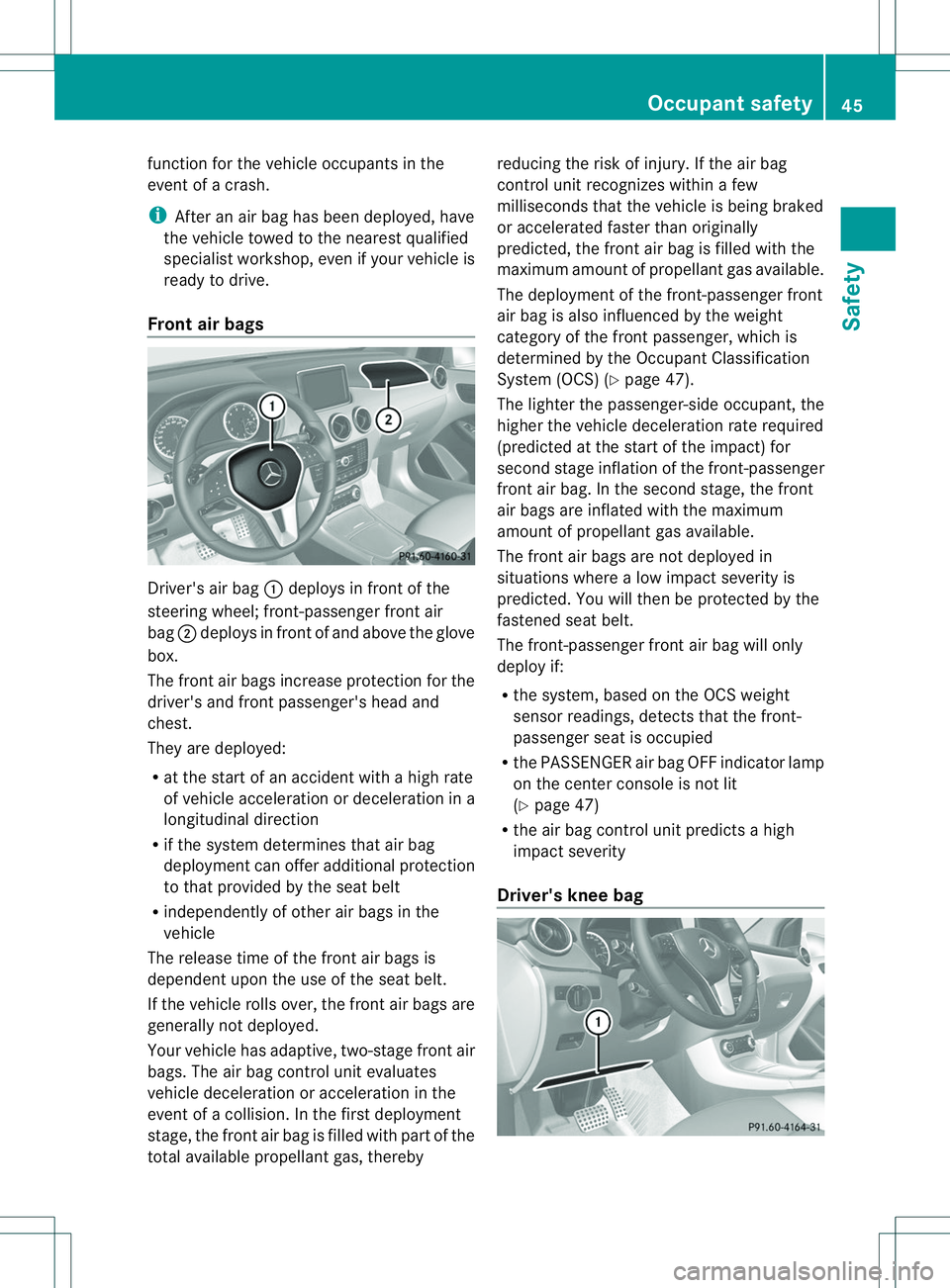
function for the vehicle occupants in the
event of acrash.
i After an airb ag has been deployed, have
th ev ehicle towed to th eneares tqualified
specialist workshop, eve nifyour vehicle is
ready to drive.
Front air bags Driver'
sair bag 001Adeploys in front of the
steerin gwheel; front-passenger front air
bag 0010deploys in front of and above the glove
box.
The front air bags increase protection for the
driver's and front passenger's head and
chest.
They are deployed:
R at the start of an accident with ahigh rate
of vehicle acceleration or deceleration in a
longitudinal direction
R if the system determines that air bag
deployment can offer additional protection
to that provided by the seat belt
R independently of other air bags in the
vehicle
The release time of the front air bags is
dependent upon the use of the seat belt.
If the vehicle rolls over, the front air bags are
generally not deployed.
Your vehicle has adaptive, two-stage front air
bags. The air bag control unit evaluates
vehicle deceleration or acceleration in the
event of acollision. In the first deployment
stage, the front air bag is filled with part of the
total available propellant gas, thereby reducing the risk of injury. If the air bag
control unit recognizes within
afew
milliseconds that the vehicle is being braked
or accelerated faster than originally
predicted, the front air bag is filled with the
maximum amount of propellant gas available.
The deployment of the front-passenger front
air bag is also influenced by the weight
category of the front passenger, which is
determined by the Occupant Classification
System (OCS) (Y page 47).
The lighter the passenger-side occupant ,the
higher the vehicle deceleration rate required
(predicted at the start of the impact) for
second stage inflation of the front-passenger
front air bag. In the second stage, the front
air bags are inflated with the maximum
amount of propellant gas available.
The front air bags are not deployed in
situations where alow impact severity is
predicted. You will then be protected by the
fastened seat belt.
The front-passenger front air bag will only
deploy if:
R the system, based on the OCS weight
sensor readings, detect sthat the front-
passenger seat is occupied
R the PASSENGER air bag OFF indicator lamp
on the center console is not lit
(Y page 47)
R the air bag control unit predicts ahigh
impact severity
Driver's knee bag Occupant safety
45Safety Z
Page 48 of 360
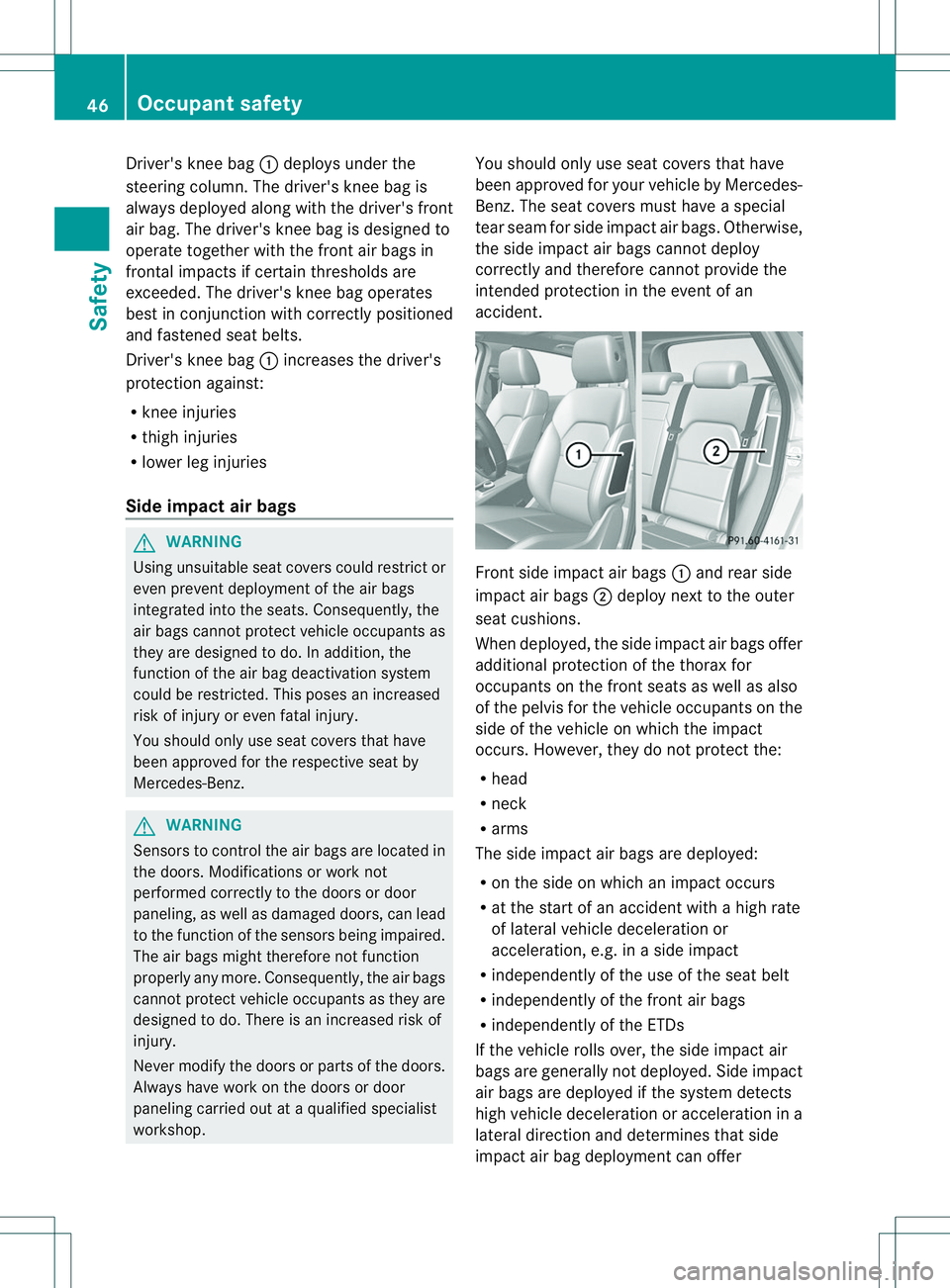
Driver's knee bag
001Adeploy sunder the
steering column. Th edriver's knee ba gis
always deployed along with the driver's front
ai rb ag. The driver' skneeb ag is designe dto
operate together wit hthe fron tair bags in
frontal impacts if certain thresholds are
exceeded. The driver's knee bag operates
best in conjunction with correctly positioned
and fastened seat belts.
Driver' skneeb ag001A increases the driver's
protection against:
R knee injuries
R thig hinjuries
R lower leg injuries
Side impact air bags G
WARNING
Usin gunsuitable seat covers could restric tor
even preven tdeployment of the air bags
integrated into the seats. Consequently, the
air bags cannot protec tvehicle occupant sas
they are designed to do. In addition, the
function of the air bag deactivation system
could be restricted. This poses an increased
risk of injury or even fatal injury.
You should only use seat cover sthat have
been approved for the respective seat by
Mercedes-Benz. G
WARNING
Sensors to control the air bags are located in
the doors. Modification sorwork not
performed correctly to the doors or door
paneling, as well as damaged doors, can lead
to the function of the sensor sbeing impaired.
The air bags might therefore not function
properly any more. Consequently, the air bags
cannot protec tvehicle occupant sasthey are
designed to do. There is an increased risk of
injury.
Never modify the doors or parts of the doors.
Always have work on the doors or door
paneling carried out at aqualified specialist
workshop. You should only use seat cover
sthat have
been approved for your vehicle by Mercedes-
Benz .The seat covers must have aspecial
tear seam for side impact air bags. Otherwise,
the side impact air bags cannot deploy
correctly and therefore cannot provide the
intended protection in the event of an
accident. Front side impact air bags
001Aand rear side
impact air bags 0010deploy next to the outer
seat cushions.
When deployed, the side impact air bags offer
additional protection of the thorax for
occupants on the front seats as well as also
of the pelvis for the vehicle occupants on the
side of the vehicle on which the impact
occurs. However, they do not protect the:
R head
R neck
R arms
The side impact air bags are deployed:
R on the side on which an impact occurs
R at the start of an accident with ahigh rate
of lateral vehicle deceleration or
acceleration, e.g. in aside impact
R independently of the use of the seat belt
R independently of the front air bags
R independently of the ETDs
If the vehicle rolls over ,the side impac tair
bags are generally not deployed. Side impact
air bags are deployed if the system detects
high vehicle deceleration or acceleration in a
lateral direction and determines that side
impac tair bag deploymen tcan offer 46
Occupant safetySafety